tow Citroen C3 PICASSO 2013 1.G Owner's Manual
[x] Cancel search | Manufacturer: CITROEN, Model Year: 2013, Model line: C3 PICASSO, Model: Citroen C3 PICASSO 2013 1.GPages: 284, PDF Size: 8.85 MB
Page 22 of 284
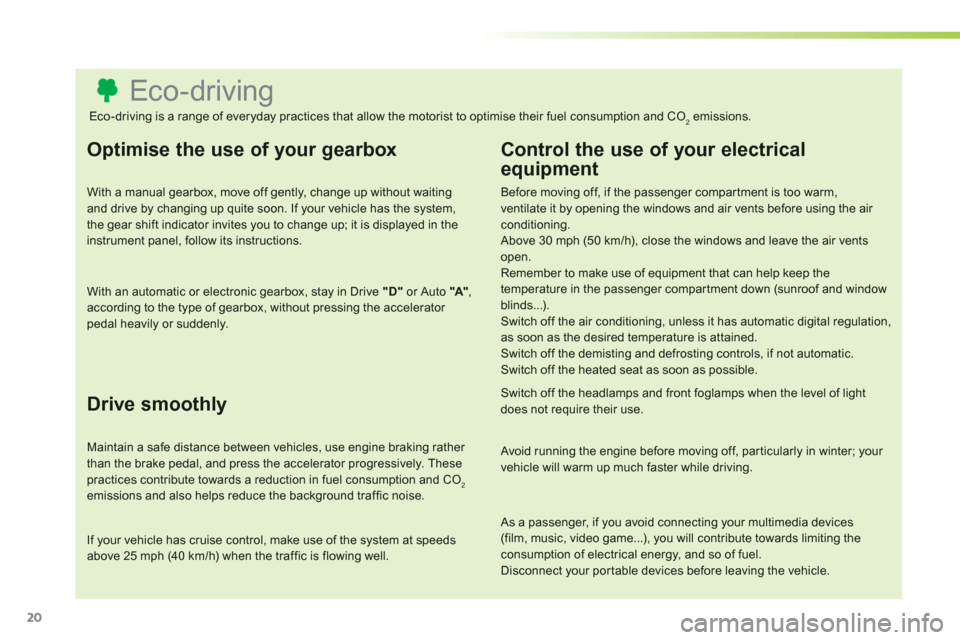
20
Eco-driving
Optimise the use of your gearbox
With a manual gearbox, move off gently, change up without waitingand drive by changing up quite soon. If your vehicle has the system,the gear shift indicator invites you to change up; it is displayed in the instrument panel, follow its instructions.
With an automatic or electronic gearbox, stay in Drive "D"
or Auto "A",according to the type of gearbox, without pressing the accelerator pedal heavily or suddenly.
Drive smoothly
Maintain a safe distance between vehicles, use engine braking rather than the brake pedal, and press the accelerator progressively. Thesepractices contribute towards a reduction in fuel consumption and CO2emissions and also helps reduce the background traffic noise.
If your vehicle has cruise control, make use of the system at speedsabove 25 mph (40 km/h) when the traffic is flowing well.
Control the use of your electrical
equipment
Before moving off, if the passenger compar tment is too warm, ventilate it by opening the windows and air vents before using the air conditioning.
Above 30 mph (50 km/h), close the windows and leave the air ventsopen.
Remember to make use of equipment that can help keep the temperature in the passenger compar tment down (sunroof and windowblinds...).
Switch off the air conditioning, unless it has automatic digital regulation,as soon as the desired temperature is attained. Switch off the demisting and defrosting controls, if not automatic. Switch off the heated seat as soon as possible.
Switch off the headlamps and front foglamps when the level of lightdoes not require their use.
Avoid running the engine before moving off, particularly in winter; your vehicle will warm up much faster while driving.
As a passenger, if you avoid connecting your multimedia devices
(film, music, video game...), you will contribute towards limiting theconsumption of electrical energy, and so of fuel.
Disconnect your por table devices before leaving the vehicle.
Eco-driving is a range of everyday practices that allow the motorist to optimise their fuel consumption and CO2emissions.
Page 25 of 284
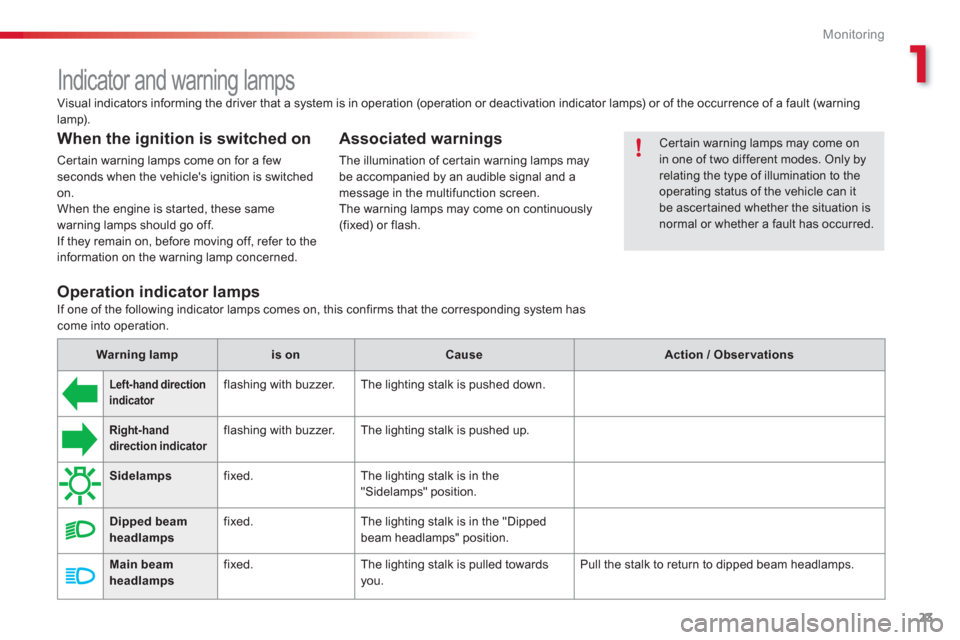
1
Monitoring
23
Indicator and warning lamps
Visual indicators informing the driver that a system is in operation (operation or deactivation indicator lamps) or of the occurrence of a fault (warning
lamp).
Associated warnings
The illumination of certain warning lamps may
be accompanied by an audible signal and amessage in the multifunction screen.
The warning lamps may come on continuously (fixed) or flash.
When the ignition is switched on
Certain warning lamps come on for a few seconds when the vehicle's ignition is switched on.
When the engine is started, these same
warning lamps should go off.
If they remain on, before moving off, refer to the
information on the warning lamp concerned.
Certain warning lamps may come onin one of two different modes. Only by relating the type of illumination to the operating status of the vehicle can itbe ascertained whether the situation isnormal or whether a fault has occurred.
Operation indicator lamps
If one of the following indicator lamps comes on, this confirms that the corresponding system has come into operation.
Warning lampis onCauseAction / Observations
Left-hand directionindicator
flashing with buzzer.The lighting stalk is pushed down.
Right-hand direction indicatorr
flashing with buzzer. The lighting stalk is pushed up.
Sidelamps
fixed. The lighting stalk is in the
"Sidelamps" position.
Dipped beamheadlamps fixed. The lighting stalk is in the "Dipped beam headlamps" position.
Main beam headlamps fixed. The lighting stalk is pulled towardsyou. Pull the stalk to return to dipped beam headlamps.
Page 53 of 284
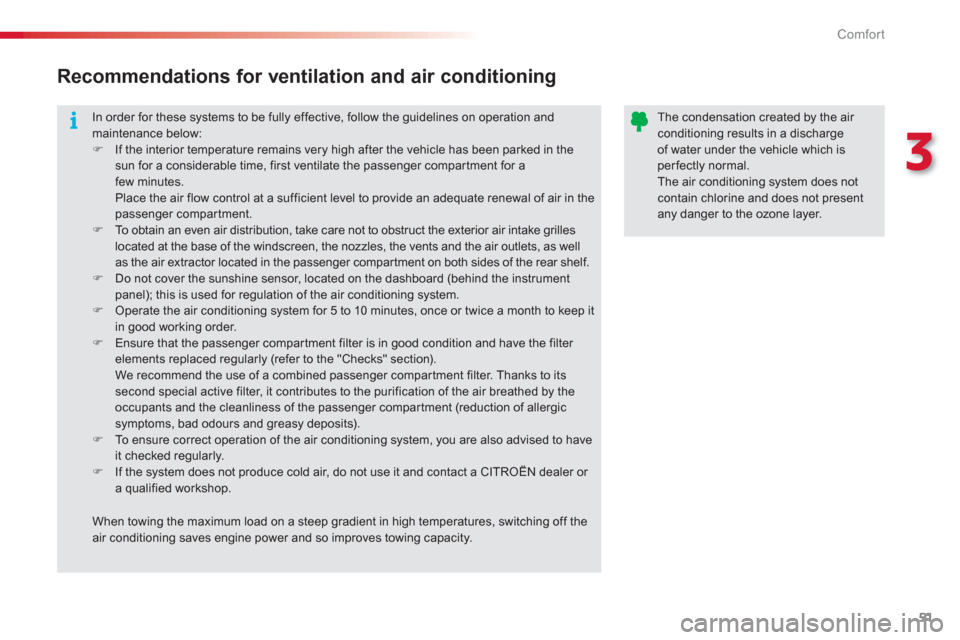
3
Comfort
51
In order for these systems to be fully effective, follow the guidelines on operation andmaintenance below:�)
If the interior temperature remains very high after the vehicle has been parked in the
sun for a considerable time, first ventilate the passenger compartment for afew minutes. Place the air flow control at a sufficient level to provide an adequate renewal of air in the passenger compartment.�)
To obtain an even air distribution, take care not to obstruct the exterior air intake grilleslocated at the base of the windscreen, the nozzles, the vents and the air outlets, as well as the air extractor located in the passenger compar tment on both sides of the rear shelf. �)
Do not cover the sunshine sensor, located on the dashboard (behind the instrument panel); this is used for regulation of the air conditioning system.�)
Operate the air conditioning system for 5 to 10 minutes, once or twice a month to keep itin good working order. �)
Ensure that the passenger compartment filter is in good condition and have the filter elements replaced regularly (refer to the "Checks" section). We recommend the use of a combined passenger compartment filter. Thanks to its second special active filter, it contributes to the purification of the air breathed by the occupants and the cleanliness of the passenger compartment (reduction of allergic symptoms, bad odours and greasy deposits).�)
To ensure correct operation of the air conditioning system, you are also advised to haveit checked regularly.�)
If the system does not produce cold air, do not use it and contact a CITROËN dealer or a qualified workshop.
The condensation created by the air conditioning results in a dischargeof water under the vehicle which is perfectly normal.
The air conditioning system does notcontain chlorine and does not present any danger to the ozone layer.
When towing the maximum load on a steep gradient in high temperatures, switching off theair conditioning saves engine power and so improves towing capacity.
Recommendations for ventilation and air conditioning
Page 59 of 284

3
Comfort
57
6. Air distribution adjustment
�)
Press one or more buttons todirect the air flow towards:
7. Air fl ow adjustment
�)
Turn this control to the left todecrease the air flow or to theright to increase the air flow.
8. Air intake / Air recirculation �)
Turn the air flow control to the left until all
of the indicator lamps go off.
This action switches off the air conditioning and
the ventilation.
Temperature related comfor t is no longer guaranteed but a slight flow of air, due to the
movement of the vehicle, can still be felt.
�) Turn the air flow dial to the right or press
the "AU TO "button to reactivate the system
with the values set before it was switched off.
�)Press this button for recirculation of the interior air. The indicator lamp in the button comes on.
- t
he windscreen and side windows (demisting or defrosting),
- the windscreen, the side windows andthe vents,
- the windscreen, the side windows,the vents and the footwells,
- the vents and the footwells,
- the vents,
- the footwells,
- the windscreen, the side windows andthe footwells.
The air
flow indicator lamps, between the twofans, come on progressively in relation to the
value requested.
�) As soon as possible, press this button
again to permit the intake of outside air and
prevent the formation of condensation. The
indicator lamp on the button switches off.
9. Mono-zone / Dual-zone
�)Press this button to equalise
the comfort value on thepassenger's side with that on
the driver's side (mono zone).
The indicator lamp in the button
comes on.
Air recirculation enables the passenger compartment
to be isolated from exterior odours and smoke.
Avoid prolonged operation in interior air recirculation mode or driving for long periods with the system off (risk of
condensation and deterioration of the air quality).
Switching the system off
Page 69 of 284
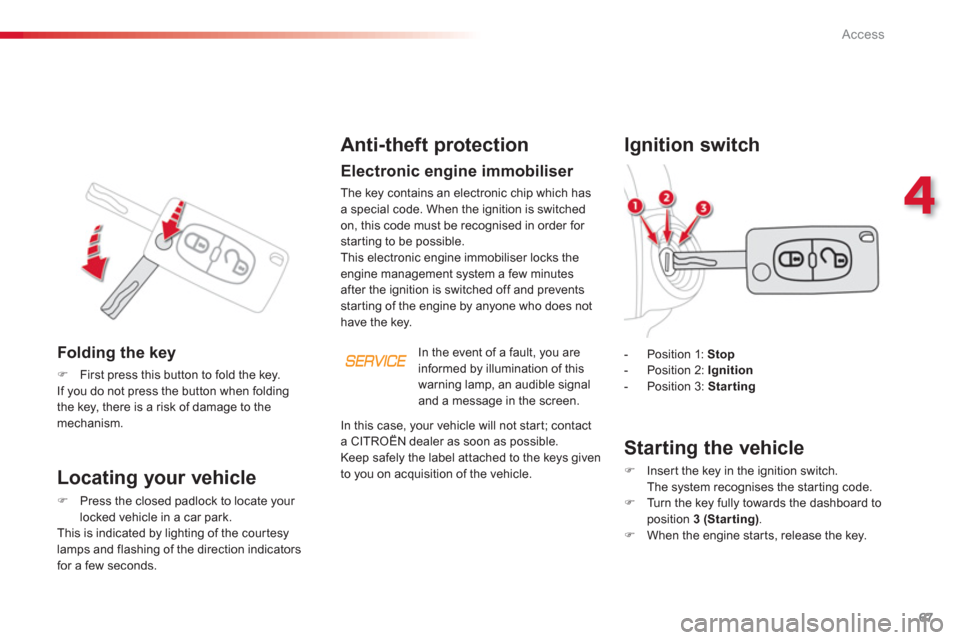
4
Access
67
Locating your vehicle
�)Press the closed padlock to locate your locked vehicle in a car park.
This is indicated by lighting of the cour tesylamps and flashing of the direction indicators for a few seconds.
Electronic engine immobiliser
The key contains an electronic chip which has a special code. When the ignition is switched
on, this code must be recognised in order for
starting to be possible.
This electronic engine immobiliser locks the
engine management system a few minutes after the ignition is switched off and prevents
starting of the engine by anyone who does not have the key.
Anti-theft protection
In the event of a fault, you are
informed by illumination of this
warning lamp, an audible signal
and a message in the screen.
Folding the key
�)First press this button to fold the key.
If you do not press the button when foldingthe key, there is a risk of damage to themechanism.
Ignition switch
- Position 1: Stop
- Position 2: Ignition
- Position 3: Starting
Starting the vehicle
�)
Inser t the key in the ignition switch.
The system recognises the star ting code.�) Turn the key fully towards the dashboard toposition 3 (Starting).�)
When the engine starts, release the key.
In this case,
your vehicle will not start; contact a CITROËN dealer as soon as possible.
Keep safely the label attached to the keys given
to you on acquisition of the vehicle.
Page 70 of 284

Access
68
Remote control problem
Following disconnection of the vehicle battery,replacement of the remote control battery or
in the event of a remote control malfunction,
you can no longer unlock, lock or locate your
vehicle. �) First of all, use the key in the lock to unlock or lock your vehicle.�)
Then, reinitialise the remote control.
If the problem persists, contact a CITROËN
dealer as soon as possible.
Changing the battery
Battery ref.: CR1620 / 3 volts.
Reinitialisation
�)
Switch off the ignition. �)
Turn the key to position 2 (Ignition on).�)
Press the closed padlock immediately for a few seconds. �)
Switch off the ignition and remove the key from the ignition switch.
The remote control is fully operational again. I
f the battery is flat, you are
informed by illumination of
this warnin
g lamp, an audible signal and a message in the
multifunction screen.
Key reminder
Switching the vehicle off
�)Immobilise the vehicle. �)Turn the key fully towards you to position 1(Stop)
. �)Remove the key from the ignition switch.
�)Unclip the casing using a coin at the notch. �)Slide the flat battery out of its location.�)Slide the new battery into its location
observing the original direction. �)Clip the casing. �)Reinitialise the remote control.
Do not attach any heavy objects to the key as this could weigh down on it when in the ignition switch and cause a fault.
If the key is left in the ignition switch, an audible signal sounds when the driver's door is opened.
Page 82 of 284

Visibility
80
Lighting controls System for selection and control of the various front and rear lamps providing the vehicle's lighting.
Main lighting
The various front and rear lamps of the vehicleare designed to adapt the driver's visibility progressively according to climatic conditions:
- sidelamps, to be seen,
- dipped beam headlamps to see without
dazzlin
g other drivers,
- main beam headlamps to see clearly when
the road is clear.
Additional lighting
Other lamps are installed to fulfil therequirements of par ticular conditions of
visibility:
- a rear foglamp to be seen from afar,
- front foglamps for even better forward
vision.
Programming
Various automatic lighting control modes are also available according to the following
options:
-
guide-me-home lighting,
- automatic illumination of headlamps.
Model without AUTO lighting
Model with AUTO li
ghting
Automatic illumination of headlamps.
Manual controls
The lighting is controlled directly by the driver
by means of the ring Aand the stalk B.
A.Main lighting mode selection ring: turn it
to position the symbol required facing themark.
Li
ghting off / daytime running lamps.
Sidelamps.
B
.Stalk for switching headlamps: pull the stalk
towards you to switch the lighting betweendipped and main beam headlamps.
In the lamps off and sidelamps modes, the driver can switch on the main beam headlamps temporarily ("headlamp flash") by maintaining a pull on the stalk.
Dipped headlamps or main
beam headlamps.
Displays
Illumination of the corresponding indicator
lamp in the instrument panel confirms that the
li
ghting selected is on.
Page 90 of 284
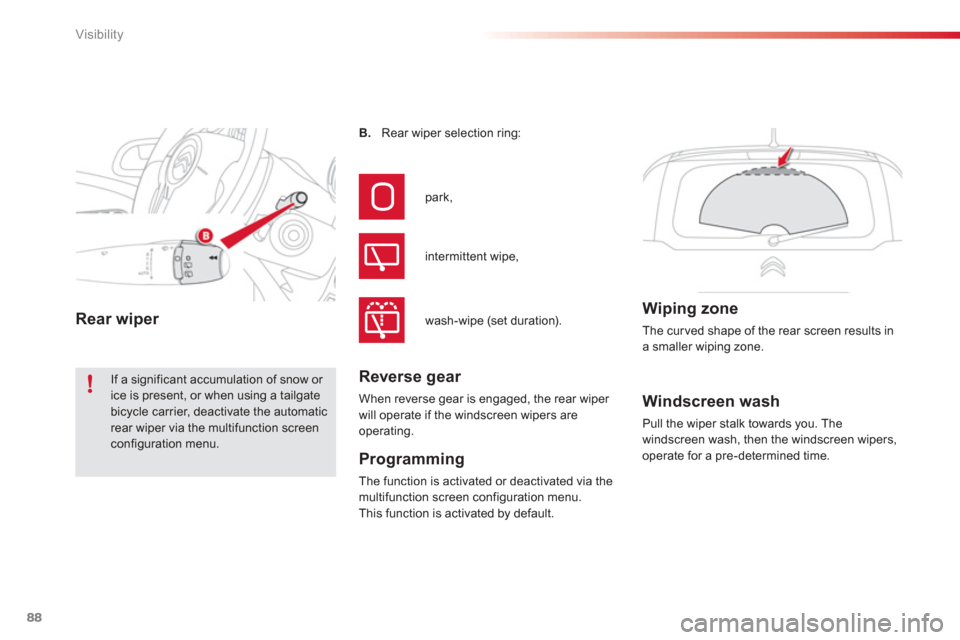
Visibility
88
Windscreen wash
Pull the wiper stalk towards you. The
windscreen wash, then the windscreen wipers,
operate for a pre-determined time. B
. Rear wiper selection ring:
park,
intermittent wi
pe,
wash-wipe
(set duration).
Reverse gear
When reverse gear is engaged, the rear wiper
will operate if the windscreen wipers are
operatin
g.
Programming
The function is activated or deactivated via the
multifunction screen configuration menu.
This function is activated by default.
Rear wiper
Wiping zone
The cur ved shape of the rear screen results in
a smaller wiping zone.
If a significant accumulation of snow or ice is present, or when using a tailgate bicycle carrier, deactivate the automatic rear wiper via the multifunction screenconfiguration menu.
Page 96 of 284

Fittings
94
Child surveillance mirror Sun visor
Provides protection against sunlight from the
front or the side.
The sun visors are
fitted with a cour tesy mirror
with concealing flap and a ticket holder.
Glove box
This has areas for storing a bottle of water, the
vehicle's handbook, etc. �)To open the glove box, pull the handle
towards you.
It is illuminated when the lid is open. A
child surveillance mirror is installed abovethe interior rear view mirror. This allows you
to monitor the vehicle’s rear passengers, or it can facilitate conversation between the front
and rear passengers without the need to move
the rear view mirror. It can be
folded away toeliminate dazzle.
Page 103 of 284

6
Fittings
101
2-position adjustable boot
The two-position adjustable boot floor allowsyou to:
- maximise the volume of the boot,
- par tition the boot
(stowing the rear shelf...),
- obtain a flat floor from the boot opening to
the front seats, when the rear bench seat is
in the folded and fully back position.
Placing the adjustable boot fl oor in the low position
�)
Lift the adjustable boot floor by pulling on
the strap. �) Move the adjustable boot floor rear wards
and then down, following the guides on the sides.
Placing the adjustable boot fl oor in the high position
�)
Lift the adjustable boot floor by pulling the strap. �)
Move the adjustable boot floor rearwards
then up to its high position.
In the high position, the adjustable boot floor
allows stowing of the rear parcel shelf andfragile objects.
The ad
justable boot floor is fitted with four stowing rings to secure your loads using the net
available as an accessory.
Ensure that your boot is empty before handling the adjustable boot floor.